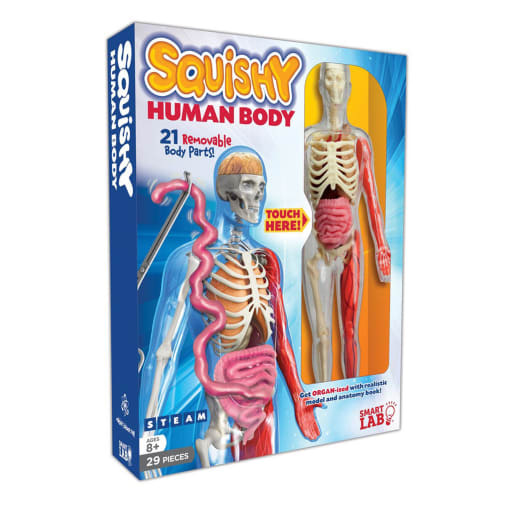These squishy, somewhat sticky organs feel incredibly lifelike! The Squishy Human Body kit teaches all about the wonderfully constructed human body, complete with all the inner workings. Kit includes a 12" transparent human body model and stand, 12 plastic bones and muscles, 9 squishy vital organs, a body parts organizer chart, tweezers and forceps for construction and "autopsy," and a colorfully illustrated 24-page book about the body, including step by step directions for completing your model.
Squishy Human Body
SKU
052446
Grade 3-AD
Neutral
Non-Consumable
These icons are designed to help you quickly understand and learn important information about our products.
Teaching Method
Traditional
Teacher-centered curriculum commonly used in classrooms that may include a text, teacher manual, tests, etc.
Charlotte Mason
A methodology based on the work of a 19th century educator who maintained that children learn best from literature (Living Books), not textbooks.
Classical
A methodology based on the Latin Trivium (three stages of learning), including the grammar stage (memorization and facts), logic stage (critical thinking), and rhetoric stage (developing/defending ideas).
Unit Study
A thematic or topical approach centered around one topic that integrates multiple subject areas.
Montessori (Discovery)
A methodology based on the work of a 20th century educator that emphasizes student and sensory-driven discovery learning and real-life applications.
Other
Other methodologies
Religious Content
Secular
Contains content contrary to common Christian beliefs (i.e. evolution).
Neutral
Avoids religious or theoretical topics or presents multiple viewpoints without preference.
Christian/Religious
Faith-based or including instructional religious content.
Learning Modality
Auditory
Learns through listening, talking out loud or reading out loud.
Visual
Learns through seeing, prefers written instructions and visual materials.
Kinesthetic/Tactile (Hands-On)
Learns through moving, doing and touching.
Multi-Sensory
Curriculum that employ a variety of activities/components.
Presentation
Sequential
Curriculum progresses through well-defined learning objectives. Emphasizes mastery before moving to the next topic.
Spiral
Topics and concepts are repeated from level to level, adding more depth at each pass and connecting with review.
Conceptual/Topical
Focus is on the “why,” often with a unifying concept as well as specific skills; coverage may be broader.
Teacher Involvement
Low Teacher Involvement
Student-led materials; parent acts as a facilitator.
Medium Teacher Involvement
A mix of teacher-led time and independent student work.
High Teacher Involvement
Teacher-led lessons; may utilize discussions, hands-on activities and working together.
Additional Materials Required
No other materials needed
Everything you need is included.
Other Materials Required
There are additional required resources that are a separate purchase.
Other Materials Optional
There are additional resources mentioned or recommended but are not absolutely necessary.
Consumable
Consumable
Designed to be written in; not reusable.
Non-Consumable
Not designed to be written in; reusable.
Our Price
$32.99 $32.99 $31.34
Rainbow Savings: $1.65
Description
Publisher's Description of Squishy Human Body
Complete with removable squishy organs as well as representative skeletal, vascular, and muscular systems, kids explore the complex inner workings of the human body and literally see how it all works. Research physician and science teacher Lucille Kayes explains how the nine vital organs work together to digest food. Squishy Human Body: a little gross—a lot of science fun!
- Discover how the human body works: Take a fascinating tour of the human body as you remove 21 realistic vital organs, bones, and muscles using the included forceps and tweezers; then rebuild the model from the toes to skullcap
- 29 pieces, exceptional value: Includes 12" clear plastic human body model, stand, 9 squishy organs, 12 plastic bones & muscles, forceps, tweezers, body part organ-izer mat, instruction sheet, 24-page illustrated anatomy book
- STEM anatomy/biology book included: Follow a slice of pizza as it travels through the body and interacts with different internal systems! With photos of real organs, engaging illustrations, and answers to common body function questions
- Perfect for budding scientists ages 8+: Great anatomy and biology lesson plan for a homeschool curriculum or for any kid (or adult) fascinated with how their body works
Contents Include:
- Human Body Model & Stand
- 9 Squishy Organs
- 12 Plastic Bones & Muscles
- Forceps
- Tweezers
- Body Part Organ-Izer
- Instruction Sheet
- 24-page Illustrated Anatomy Book
Category Description for Squishy Anatomy
Squishy science is a unique way to explore human body systems. Read on for details about each kit.
Details
| Product Format: | Other |
|---|---|
| Grades: | 3-AD |
| Brand: | SmartLab |
| EAN/UPC: | 860009347328 |
| Length in Inches: | 13 |
| Width in Inches: | 10 |
| Height in Inches: | 2.5625 |
| Weight in Pounds: | 1.3 |
Videos
Reviews

